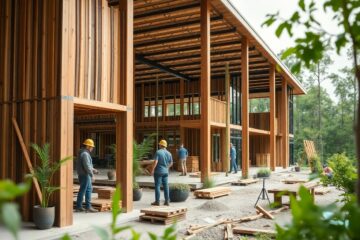Regenerative design is a concept that looks to nature for inspiration on creating sustainable and innovative architectural solutions. By mimicking the processes and systems found in the natural world, architects and designers are able to create structures that not only minimize their environmental impact but actually contribute positively to their surroundings. This approach not only benefits the environment but also creates healthy and thriving spaces for occupants. In this blog post, we will explore how regenerative design principles are revolutionizing the architecture industry and leading the way towards a more sustainable future.
Table of Contents
Principles of Regenerative Design
Before delving into the intricacies of regenerative design, it is essential to understand the core principles that guide this innovative approach. Regenerative design is rooted in the idea of creating built environments that mimic the processes of natural ecosystems. By drawing inspiration from the efficient and sustainable systems found in nature, architects and designers can develop solutions that not only minimize negative impacts but also contribute positively to the environment.
Sustainable Materials and Resources
Any regenerative design project begins with a focus on sustainable materials and resources. This involves choosing materials that are renewable, recycled, or upcycled to reduce the demand for virgin resources and minimize waste. Additionally, the lifecycle of materials, including their extraction, production, use, and disposal, is carefully considered to ensure minimal environmental impact.
Furthermore, regenerative design emphasizes the importance of local sourcing to reduce transportation emissions and support the local economy. By prioritizing materials that are abundant in the region where the project is located, designers can minimize the carbon footprint of the construction process and promote regional diversity.
Renewable Energy Integration
Renewable energy integration is a crucial aspect of regenerative design, focusing on harnessing clean, sustainable energy sources to power buildings and infrastructure. Incorporating technologies such as solar panels, wind turbines, and geothermal systems allows projects to reduce their reliance on fossil fuels and decrease greenhouse gas emissions. By generating renewable energy on-site or sourcing it from off-site renewable sources, regenerative design projects can significantly reduce their carbon footprint.
Renewable energy integration goes beyond simply reducing energy consumption; it aims to create energy-independent structures that can potentially produce more energy than they consume. This approach not only benefits the environment by reducing greenhouse gas emissions but also increases resilience against energy price fluctuations and supply disruptions.
Architectural Innovations Inspired by Nature
Structural Designs Mimicking Natural Forms
Assuming that nature has perfected the art of design over millions of years, architects have looked to natural forms for inspiration in creating innovative structural designs. Mimicking the strength and efficiency of natural structures such as tree branches, honeycombs, and shells, architects have been able to create buildings that are not only aesthetically pleasing but also highly functional.
By studying the way natural systems distribute loads, resist external forces, and optimize material use, architects have been able to develop new techniques and materials for construction. This approach has resulted in buildings that are not only visually striking but also highly sustainable and resilient.
Incorporating Natural Elements for Climate Control
Structural innovations inspired by nature also include incorporating natural elements for climate control within buildings. By studying how trees provide shade, wind patterns are affected by natural landforms, and how animals burrow underground for thermal insulation, architects have been able to design buildings that passively regulate temperature and reduce energy consumption.
Climate change has made it imperative for architects to find ways to reduce the carbon footprint of buildings. By incorporating natural elements such as green roofs, rainwater harvesting systems, and natural ventilation strategies, architects can create buildings that not only reduce energy consumption but also contribute positively to the environment.
Challenges and Solutions in Regenerative Architecture
Balancing Aesthetics with Functionality
Solutions in regenerative architecture often require a delicate balance between aesthetics and functionality. While the visual appeal of a building is crucial in architecture, it must not come at the cost of environmental performance. Architects need to find ways to merge beauty with sustainability, ensuring that the design not only pleases the eye but also works harmoniously with the surrounding ecosystem.
One solution to this challenge is to integrate nature-inspired elements into the architectural design. By drawing inspiration from patterns and systems found in nature, architects can create buildings that are both visually striking and environmentally friendly. This approach not only enhances the aesthetic value of the structure but also promotes sustainability in the built environment.
Overcoming Technological and Material Limitations
Regenerative architecture faces obstacles related to technological and material limitations. Advancements in technology have enabled architects to explore innovative design solutions, but these can be restricted by the availability of sustainable materials. Regenerative design requires a careful selection of materials that minimize environmental impact while still meeting structural requirements.
In overcoming technological and material limitations, architects are embracing a holistic approach that considers the entire life cycle of a building. This involves not only the initial construction phase but also maintenance, operation, and eventual deconstruction. By prioritizing durability, recyclability, and renewability in material choices, architects can contribute to regenerative practices that benefit both the environment and future generations.
Future of Regenerative Design in Architecture
Advances in Technology and Materials
After embracing regenerative design principles, architects are now looking towards the future to explore new advances in technology and materials. With the rapid evolution of technology, architects have access to innovative tools such as parametric design software, advanced modeling techniques, and sustainable materials like engineered wood products and recycled composites. These advancements have revolutionized the way buildings are designed, constructed, and maintained.
Designing with regenerative principles in mind allows architects to create structures that not only minimize negative environmental impacts but also actively contribute to the well-being of the ecosystem. High-performance materials such as self-healing concrete, photovoltaic glass, and biodegradable composites are paving the way for sustainable architectural innovations that blur the lines between nature and the built environment.
The Role of Policy and Education in Promoting Sustainable Practices
Designers must consider not only the physical aspects of regenerative architecture but also the role of policy and education in promoting sustainable practices. Governments around the world are implementing green building codes and sustainability standards to encourage architects to incorporate regenerative design principles into their projects. Additionally, educational institutions are increasingly focusing on environmental stewardship and sustainable practices in architectural curricula.
Materials play a crucial role in shaping the future of regenerative design in architecture. By selecting environmentally-friendly materials, architects can significantly reduce the ecological footprint of buildings and contribute to a more sustainable built environment. Policies that promote the use of renewable resources and incentivize the adoption of regenerative design practices are key to driving the transition towards a more sustainable architectural industry.
FAQ
Q: What is regenerative design?
A: Regenerative design is an approach to design that is inspired by nature’s sustainable systems. It aims to create an ecosystem of interconnected elements that not only minimize harm to the environment but also actively contribute to its regeneration.
Q: How does nature inspire architectural innovations in regenerative design?
A: Nature serves as a rich source of inspiration for regenerative design by providing sustainable solutions that have evolved over millions of years. Architects and designers study natural systems and processes to mimic them in their designs, leading to more efficient and environmentally friendly buildings.
Q: What are some key principles of regenerative design in architecture?
A: Some key principles of regenerative design in architecture include biomimicry (mimicking nature’s forms and processes), circular economy (minimizing waste and using resources efficiently), and holistic thinking (considering the interconnectedness of all elements in a design).
Q: How can regenerative design benefit the environment?
A: Regenerative design can benefit the environment in multiple ways, such as reducing energy consumption, minimizing waste production, and promoting biodiversity. By emulating nature’s sustainable systems, regenerative design helps create a built environment that works in harmony with the natural world.
Q: What are some examples of regenerative design in modern architecture?
A: Some examples of regenerative design in modern architecture include green roofs that support biodiversity and reduce stormwater runoff, passive solar design that maximizes natural light and heat, and buildings made from sustainable materials that can be easily recycled or reused. These innovations showcase the beauty and effectiveness of regenerative design in creating a more sustainable future.

Our contributing author is a passionate advocate for eco-friendly living and sustainability. With a background in eco-life, they are dedicated to inspiring and empowering individuals to adopt environmentally conscious lifestyles. Through insightful articles, they share practical tips, innovative solutions, and thought-provoking perspectives to promote a greener, more sustainable world. Join them on the journey towards eco-smart living and discover how small choices can make a big impact. 🌱









